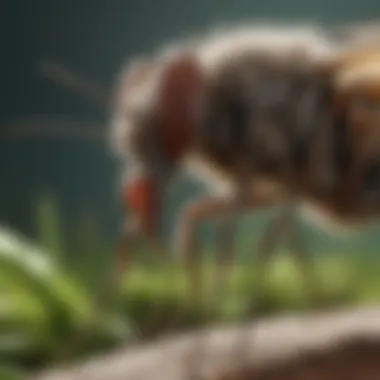Understanding Effective Pesticides for Mosquito Control


Overview of the Topic
Definition and Importance
Pesticides for mosquito control play a crucial role in managing vector-borne diseases such as malaria, dengue fever, and West Nile virus. These diseases present significant public health threats globally. Mosquitoes, as vectors, contribute to the transmission of these pathogens, making effective control essential. The use of pesticides is a strategy employed by agricultural professionals, public health officials, and private property owners to curb mosquito populations and reduce the risk of disease outbreaks. Understanding the various types of pesticides can enhance the effectiveness of control measures and ensure the health and safety of the public and the environment.
Current Trends
Currently, there is a notable shift towards using environmentally sustainable practices in mosquito control. Natural pesticides, such as those derived from plant extracts, are gaining traction due to their lower toxicity and reduced impact on non-target species. Additionally, biopesticides play an important role in targeting mosquito larvae without harming beneficial insects. Moreover, synthetic options are continually being evaluated for their effectiveness and safety, leading to advancements in formulations that minimize adverse effects. Keeping abreast of these trends is vital for those involved in agriculture and pest management.
Key Techniques and Practices
Step-by-Step Guide
- Assessment of Mosquito Populations: Begin by identifying the species and the extent of the infestation. This is essential for selecting the most effective pesticide.
- Choosing the Right Pesticide: Depending on the assessment, choose between natural or synthetic pesticides. Each type has its strengths tailored for specific situations.
- Application Method: Determine the most effective application method, whether it’s aerial spraying, fogging, or ground application. The method significantly influences effectiveness.
- Monitoring and Evaluation: Post-application, continue to monitor mosquito populations to evaluate the effectiveness of the pesticide used.
- Adjustments if Necessary: Based on evaluation, make necessary adjustments either in pesticide choice or application method for optimal results.
Tools and Equipment Needed
- Sprayers: Various types of sprayers, including backpack sprayers and mist blowers for different application methods.
- Protective Gear: Safety goggles, masks, and gloves to ensure the safety of the applicator.
- Measuring Instruments: To accurately measure pesticide concentrations for effective application.
Challenges and Solutions
Common Obstacles
- Resistance Development: Over time, mosquito populations can develop resistance to certain pesticides. This necessitates the rotation and combination of different products.
- Environmental Concerns: The impact of pesticides on non-target species and overall ecosystem health can lead to scrutiny from environmental groups and regulatory bodies.
- Public Perception: There can be a public backlash against pesticide use, driven by health concerns. Educating the community about the benefits and safety of targeted application is essential.
Innovative Solutions
- Integrated Pest Management (IPM): This approach combines biological control, habitat manipulation, and the judicious use of pesticides to reduce reliance on chemical solutions.
- Public Awareness Campaigns: Engaging in community outreach to educate about the necessity and safety of mosquito control measures.
- Collaboration with Local Governments: Establishing partnerships with local authorities can enhance program credibility and effectiveness, ensuring a more sustainable approach.
Prologue to Mosquito Control
Mosquito control is a critical aspect of public health. The importance of managing mosquito populations cannot be overstated. Mosquitoes are vectors for various diseases, including malaria, dengue fever, and Zika virus. These diseases present significant risks to health, especially in tropical regions. Controlling mosquito populations effectively helps reduce the incidence of these diseases, ultimately saving lives and ensuring healthier communities.
Effective mosquito management involves a multifaceted approach. This includes understanding the biology of mosquitoes, their breeding habits, and the most effective methods for control. Each method can have different levels of effectiveness and environmental impacts. This article explores the various types of pesticides available, their mechanisms of action, and how they can be applied within an integrated mosquito management (IMM) strategy.
Importance of Effective Mosquito Management
Proper mosquito management has several crucial benefits. Firstly, protecting public health is paramount. A decline in mosquito populations can lead to a decrease in disease transmission, benefiting both individuals and communities. Additionally, reducing mosquito numbers can enhance the quality of life in affected areas. Outdoor activities may become more enjoyable when mosquitoes are less prevalent.
Moreover, effective management can also have economic benefits. Mosquito-related diseases can incur high health care costs. By controlling mosquito populations, these costs may be significantly reduced, easing the burden on health care systems.
Overview of Pesticides in Agriculture
Pesticides have long been part of agriculture and pest management strategies. While they often face scrutiny, they remain essential tools in controlling pests, including mosquitoes. Pesticides can be broadly categorized into chemical, biological, and natural options, each with distinct characteristics and applications.
Chemical pesticides, such as pyrethroids, are widely used for their effectiveness in killing adult mosquitoes. Biological pesticides, like Bacillus thuringiensis israelensis, target mosquito larvae specifically, which ensures a more environmentally friendly approach. On the other hand, natural pesticides, derived from plant extracts, offer alternative solutions for those concerned about chemical exposure.
While using pesticides, it is critical to consider their impact on the ecosystem. Overreliance on any single control method can lead to resistance and an imbalance in local fauna and flora. Therefore, a well-rounded understanding of pesticide use and their respective impacts is essential for effective mosquito management.
Types of Pesticides for Mosquitoes
The selection of pesticides for mosquito control is pivotal in effective pest management. There are various types of pesticides that serve to combat mosquito populations. Each type has unique properties and applications that can influence effectiveness, environmental safety, and health. Understanding these types is essential for choosing an appropriate method for mosquito management and ensuring minimum adverse effects on surrounding ecosystems.
Chemical Pesticides
Chemical pesticides are among the most commonly used products for mosquito control. They typically work by disrupting the insect's nervous system. Pyrethroids, for instance, are widely used due to their effectiveness and low mammalian toxicity. These compounds target receptors in the mosquito's nervous system, inducing paralysis and ultimately leading to death.
Chemical pesticides are often preferred for rapid results, especially in large-scale applications like aerial spraying over urban areas.
However, there are important considerations when using chemical pesticides. Some mosquitoes have developed resistance, meaning that the same compounds may become less effective over time. Moreover, care must be taken to avoid contaminating water sources, as many chemical pesticides can harm aquatic life. Integrated Pest Management strategies often recommend rotating different chemical classes to minimize resistance development.
Biological Pesticides
Biological pesticides offer an alternative to chemical solutions. These are derived from naturally occurring organisms or substances. One well-known example is Bacillus thuringiensis israelensis (Bti). This bacterium produces toxins that specifically target mosquito larvae without harming other species.
Benefits of using biological pesticides include:
- Target specificity: Only affects mosquitoes and related species, reducing collateral damage to beneficial insects.
- Environmental safety: Biological products tend to break down more rapidly in the environment, lowering long-term impacts.
Despite these advantages, biological pesticides may require multiple applications to maintain effectiveness, especially in areas with high mosquito populations.
Natural Pesticides
Natural pesticides, often derived from plant extracts, are gaining traction due to increasing concerns about chemical pesticide residues. Essential oils such as citronella and lemongrass oil are known for their repellent properties. While they may not eliminate mosquitoes, they can offer short-term relief in outdoor settings.


When considering natural pesticides, it's essential to recognize their limitations:
- Efficacy: Natural pesticides may not possess the same efficacy as their synthetic counterparts.
- Regulation: Natural ingredients are not always subject to the same rigorous evaluations as conventional pesticides, which can lead to variability in quality and effectiveness.
In summary, the types of pesticides for mosquito control are diverse. Chemical, biological, and natural pesticides each offer benefits and drawbacks. Understanding these differences can empower agricultural professionals and enthusiasts to tailor their approach for effective mosquito management.
Mechanisms of Action
Understanding the mechanisms of action for various pesticides is crucial for effectively controlling mosquito populations. This section delves into how different substances work to eliminate or inhibit mosquitoes, focusing on their biological interactions. By grasping these mechanisms, agricultural professionals and enthusiasts can make informed decisions about pesticide selection, ensuring they choose options that align with their control objectives.
Neurotoxins and Their Effects
Neurotoxins play a significant role in mosquito control. These chemicals disrupt normal neural function in insects. They target the nervous system, leading to paralysis or death. Common neurotoxic pesticides include compounds from the pyrethroid family, like permethrin and cypermethrin.
When mosquitoes come into contact with these pesticides, the neurotoxins bind to sodium channels within their nerve cells. This action leads to an uncontrolled influx of sodium ions, resulting in continuous nerve signaling. The consequences are detrimental to the mosquito’s ability to function, ultimately resulting in death.
The effectiveness of neurotoxins can also affect non-target species, raising concerns in ecological contexts. Therefore, it's vital to consider the potential risks to beneficial insects and other organisms in the vicinity when applying these pesticides.
Growth Regulators
Growth regulators serve as an alternative method for mosquito management. These substances mimic or interfere with hormones essential for the development of insects. By disrupting the hormonal regulation of growth, these pesticides prevent the proper maturation of mosquito larvae into adult forms. In particular, methoprene is a well-known growth regulator used in various mosquito control strategies.
Application of growth regulators tends to focus on larval stages of mosquitoes. This can provide a targeted approach that reduces adult populations over time. They are often considered less harmful to non-target species, making them a more environmentally friendly choice when applied correctly. However, the timing of application and environmental conditions influence their effectiveness significantly.
Insect Growth Inhibitors
Insect growth inhibitors work by blocking the synthesis of chitin, which is crucial for the formation of exoskeletons in mosquitoes. This leads to incomplete molting and, ultimately, the death of the insect. Compounds like benzoylphenyl urea are examples of this class.
The application of insect growth inhibitors can be quite effective in reducing mosquito populations, especially when used in conjunction with other control methods. They not only limit the growth of mosquito populations but also reduce the overall number of adult mosquitoes. This dual effectiveness can help in achieving long-term control of mosquito numbers in an area.
In summary, understanding the mechanisms of action for neurotoxins, growth regulators, and insect growth inhibitors provides a multifaceted view of mosquito control strategies. Knowledge of how these substances function at a biological level empowers users to select the most appropriate methods for effective mosquito management.
Criteria for Choosing Pesticides
Choosing the right pesticides for mosquito control requires careful evaluation of various factors. This process is crucial because improper choices can lead to ineffective control, environmental degradation, and health risks. Understanding these criteria allows agricultural professionals, horticulturists, and enthusiasts to make informed decisions.
Efficacy in Mosquito Control
The primary concern when selecting a pesticide is its efficacy in controlling mosquito populations. Efficacy refers to how effectively a pesticide can reduce or eliminate mosquito numbers. Various pesticides, such as pyrethroids and Bacillus thuringiensis israelensis, each have different levels of effectiveness based on their mechanisms of action. For example, certain pyrethroids attack the nervous system of mosquitoes, leading to paralysis and death. When evaluating efficacy, it is essential to consider the targeted species of mosquitoes and any resistance they may have developed.
Conducting pre-application assessments can provide data on current mosquito populations, which in turn helps in determining the most effective pesticide to use. It is also helpful to review field trials and research studies that illustrate the efficacy levels of different products.
Environmental Impact
An important criterion is the environmental impact of the pesticide. Many pesticides can unintentionally affect non-target species, including beneficial insects, birds, and aquatic life. Thus, understanding the potential ecological consequences is vital. For example, some synthetic pesticides may persist in the environment, leading to soil and water contamination. On the other hand, natural pesticides may break down more quickly and pose less risk to the ecosystem, but their effectiveness can vary greatly.
"Choosing a pesticide involves balancing the need for efficiency in mosquito control with the imperative to minimize environmental damage."
Evaluating the environmental risks involves several dimensions, including:
- Persistence: How long the pesticide remains active in the environment.
- Bioaccumulation: Whether harmful substances accumulate in the food chain.
- Impact on biodiversity: The extent to which the pesticide affects various species.
Health Considerations
Health considerations are paramount in the choice of pesticides. Pesticides, especially those applied in populated areas, have potential health impacts on humans and pets. Pesticides can cause short-term effects such as irritation and long-term effects like chronic illnesses and cancer, depending on exposure levels. It is crucial to choose products that are safe and have minimal toxicity.
Before applying any pesticide, reading the label carefully is essential. The label includes important information on the potential health risks, recommended application rates, and necessary safety precautions. Integrated Pest Management (IPM) strategies can also play a vital role in risk reduction, as they combine chemical and non-chemical methods for better effectiveness and safety.
Taking into consideration human health involves, among other aspects:
- Toxicity levels: Understanding risk categories assigned to pesticides.
- Safety guidelines: Following application protocols to minimize exposure.
- Alternatives: Exploring non-chemical methods that achieve mosquito control without risks.
Top Pesticides for Mosquitoes
The topic of Top Pesticides for Mosquitoes is crucial in the landscape of pest management. Selecting the right pesticide is essential for effective control of mosquito populations. These pests not only cause discomfort but also pose health risks as they can transmit diseases such as Zika, West Nile Virus, and malaria. Thus, understanding which pesticides are most effective and suitable for specific environments is vital for agricultural professionals and enthusiasts.
Effective pesticides must balance efficacy and safety. Some options work best in urban settings while others are more suitable for rural areas. Each pesticide type has unique mechanisms of action, potential side effects, and degrees of environmental impact. Knowing this information allows for informed decision-making, ensuring that mosquito control efforts are successful while minimizing negative effects on surrounding ecosystems.
Pyrethroids
Pyrethroids are synthetic chemicals modeled after pyrethrins, which are derived from chrysanthemum flowers. They are widely used due to their high efficacy against adult mosquitoes. Pyrethroids interfere with the insect's nervous system, leading to paralysis and eventual death. Their fast action and relatively low toxicity to humans and animals make them favored in many mosquito control programs.
A significant benefit of pyrethroids is their ability to remain effective over time in various environments. However, overuse can lead to resistance in mosquito populations, necessitating the exploration of alternative control strategies. Proper application is vital to minimize environmental impact and improve outcomes in mosquito control efforts.
Bacillus thuringiensis israelensis


Bacillus thuringiensis israelensis (Bti) is a biological agent that targets mosquito larvae. It produces a toxin that specifically affects the digestive systems of certain insects. When Bti is applied to water sources, it can effectively control larvae without harming beneficial insects and other wildlife.
Using Bti offers several advantages. It is a naturally occurring bacterium, which means it is less likely to cause chemical pollution. Additionally, it has a low toxicity profile, making it safer for public health. However, Bti’s effectiveness is limited to its application in standing water, and it must be reapplied frequently to maintain effectiveness.
Application Methods
The application methods for pesticides play a crucial role in their effectiveness and efficiency in managing mosquito populations. The choice of method can significantly affect the pesticide’s ability to cover the target areas adequately and minimize wastage. Understanding these processes is essential for agricultural professionals and enthusiasts seeking to optimize pest control efforts while considering safety and environmental impacts.
Aerial Spraying vs Ground Applications
Aerial spraying and ground applications are two primary methods for applying pesticides to control mosquito populations.
Aerial Spraying involves the use of aircraft to distribute pesticides over large areas quickly. This method is particularly beneficial in dense urban settings and expansive rural areas where mosquitoes are abundant. The main advantages include:
- Rapid Coverage: Aerial applications can treat vast areas in a short time, making them effective in quick response situations.
- Access to Difficult Locations: Aircraft can reach areas that are hard to access by ground vehicles, such as wetlands or dense forests.
- Uniform Distribution: When properly calibrated, aerial spraying can ensure a more even distribution of pesticide, enhancing effectiveness.
However, aerial spraying also presents challenges such as potential drift, where pesticides can move away from the target area due to wind. Additionally, it may impact non-target organisms and pose health risks to nearby communities if not managed correctly.
Ground Applications, on the other hand, involve using trucks, hand-held sprayers, or backpacks to apply pesticides directly to the ground. Some benefits include:
- Precision: Ground applications allow for more targeted delivery, minimizing the risk to non-target species and the environment.
- Flexibility: They can be adapted for various terrains, making it easier to apply in small, intricate spaces.
- Lower Risk of Drift: With ground applications, there is less chance for pesticides to drift away from established boundaries.
Nevertheless, ground applications can be labor-intensive and may take longer to cover large areas compared to aerial methods.
In deciding between aerial spraying and ground applications, practitioners must consider factors such as the size of the target area, the density of the mosquito population, access to the site, and potential impacts on the environment and human health.
Targeted Delivery Systems
Targeted delivery systems refer to innovative methods designed to release pesticides more precisely, minimizing unnecessary exposure and maximizing effectiveness. These systems often rely on advanced technologies, such as:
- Smart Sprayers: Utilizing sensors and GPS technology, these systems can detect mosquito presence and apply the pesticide only where needed.
- Microencapsulation: This technique involves encasing pesticides in tiny capsules that dissolve slowly, releasing the active ingredients over time to enhance control while reducing overall pesticide use.
- Time-Release Devices: These devices are designed to release a controlled amount of pesticide at scheduled intervals, ensuring effective mosquito control without repetitive applications.
By implementing targeted delivery systems, agricultural professionals and enthusiasts can achieve a more sustainable approach to mosquito control. These systems help in reducing the total amount of pesticide used, lower the risks to non-target organisms, and maintain efficacy in managing mosquito populations.
Overall, understanding application methods and implementing targeted delivery systems are essential for effective mosquito management. Choosing the right strategy can lead to optimal control, ensuring both human health and environmental safety are prioritized.
Integrated Pest Management Strategies
Integrated Pest Management (IPM) for mosquito control is a multifaceted approach that combines various methods to manage and reduce mosquito populations effectively. The importance of IPM lies in its capacity to minimize dependency on chemical pesticides while optimizing their effectiveness when used. This strategy considers ecological balance and human health, emphasizing a more sustainable method of pest management.
Combining Chemical and Non-Chemical Approaches
Chemical pesticides have long been a staple in mosquito control. However, their indiscriminate use can lead to pesticide resistance and environmental consequences. Thus, integrating chemical solutions with non-chemical methods becomes essential.
Non-chemical approaches include biological controls, such as introducing natural predators like fish that eat mosquito larvae, and habitat management, such as eliminating standing water. Incorporating these methods can help reduce the overall need for chemical applications, leading to safer and more sustainable mosquito control.
Benefits of this combination include:
- Reduction in Resistance: Using non-chemical methods can lower the chances of mosquitoes developing resistance to chemical pesticides.
- Environmental Protection: Non-chemical methods help preserve local ecosystems and minimize chemical runoff into water sources.
- Cost-Effectiveness: Reducing the reliance on chemical pesticides can ultimately lower costs for farmers and municipalities.
Monitoring and Assessment Techniques
Effective mosquito control requires robust monitoring and assessment techniques to determine the most effective methods to deploy. These techniques not only inform about current mosquito populations but also help in evaluating the efficacy of the chosen control measures.
Methods of monitoring include:
- Trap Count: Utilizing traps to capture adult mosquitoes can provide critical data on their density and species distribution.
- Larval Surveys: Inspecting areas for mosquito larvae can indicate where control measures may be necessary.
- Environmental Assessments: Regularly assessing breeding sites and environmental conditions can help anticipate future outbreaks.
One advantage of these techniques is their role in creating data-driven management decisions. As one expert noted, > "Effective management lies in understanding the target population dynamics over mere application of pesticides."
Regulatory Considerations
Regulatory considerations play a crucial role in the effective use of pesticides for mosquito control. The significance of regulations lies in their ability to ensure that products used in pest control are safe for both humans and the environment. Regulation creates a framework that manufacturers must adhere to, which often involves rigorous testing and evaluation of pesticide safety and effectiveness. It helps in preventing the use of harmful or ineffective products that could compromise public health or damage ecosystems.
Pesticide Approval Processes
The pesticide approval process is a comprehensive procedure that involves multiple stages. Initially, a pesticide must undergo laboratory testing to assess its potential impacts on human health and the environment. Following this, field trials are conducted to evaluate its efficacy against target pest species, including mosquitoes. The data collected from these studies are submitted to regulatory authorities. In the United States, organizations such as the Environmental Protection Agency (EPA) oversee this process. They review the submitted data thoroughly before granting approval. This process ensures that only products meeting safety and efficacy standards reach the market.
- Pre-Submission: Manufacturers conduct initial testing.
- Data Collection: Information on safety and effectiveness is gathered.
- Submission to Authorities: The data is presented to regulatory agencies.
- Review Process: Agencies review and assess the findings rigorously.
- Approval/Denial: Final decision on whether the pesticide can be marketed.
The entire process can be lengthy, often taking years before a product can be approved. This is vital to ensure products will not cause harm to users or the environment.
Labeling Requirements
Labeling requirements are also a fundamental aspect of pesticide regulation. Every pesticide product must have a label that clearly outlines its intended use, application methods, and safety precautions. The labels serve multiple purposes: they inform the user about how to apply the product safely and effectively, outline potential risks, and guide in case of an emergency.


"Clear labeling ensures responsible use of pesticides, minimizing their risks to non-target organisms and humans."
Some critical elements found on pesticide labels include:
- Active Ingredients: Identifies the substances that target mosquitoes.
- Application Instructions: Clear guidelines on how to use the pesticide.
- Safety Information: Includes protective measures for users handling the pesticide.
- Environmental Precautions: Highlights any risks to non-target species or ecosystems.
Regular updates to labeling requirements reflect the latest scientific findings and ensure public safety. These regulations enhance transparency and trust among consumers, enabling informed decisions in pest management.
In summary, regulatory considerations encompass pesticide approval processes and labeling requirements that together promote responsible pest control practices. They assure that the pesticides used are effective and safe for human health and the environment.
Case Studies in Effective Mosquito Control
Case studies serve as valuable resources when exploring effective insect management, especially concerning mosquitos. They provide real-world insights into what strategies have worked and what challenges have arisen in various environments. Understanding these elements can guide agricultural professionals in selecting appropriate pest control measures that reflect local ecological conditions.
The advantages of focusing on case studies include the ability to assess the effectiveness of different techniques, the adaptability of strategies to local demands, and the identification of potential pitfalls. Through documented field trials, we can learn about innovative approaches to pest management, explore community responses, and gauge the impact of specific pesticides within a defined context.
Urban Mosquito Management
Urban settings frequently present unique challenges for mosquito control. In densely populated environments, effective management requires nuanced strategies that respect both human health and environmental balance. Cities, with their diverse habitats, create an intricate web of breeding grounds for mosquitos. Effective urban mosquito control often employs integrated pest management (IPM) strategies.
Several urban case studies highlight the successful use of Bacillus thuringiensis israelensis, or Bti, a biological pesticide, which targets mosquito larvae specifically without harming non-target organisms. This approach is especially effective in stagnant water bodies common in urban landscapes.
Key considerations in urban mosquito management include:
- Community engagement: Involving residents in awareness campaigns about stagnant water management helps reduce breeding sites.
- Strategic monitoring: Regularly assessing mosquito populations and breeding habitats ensures that interventions happen timely.
- Use of technology: Implementing drones for aerial spraying has shown promise in reaching hard-to-access areas efficiently.
The synergy of these strategies in urban environments has proven to reduce mosquito populations significantly, leading to lower incidences of mosquito-borne diseases.
"Urban environments require tailored mosquito control strategies that synchronize public health with ecological integrity."
Rural Strategies
Rural areas, with their vast land and natural habitats, often require a different approach to mosquito control. In these settings, it’s crucial to balance agricultural activities and the management of water bodies that serve as mosquito breeding grounds. Case studies from rural regions demonstrate the successful implementation of natural pesticides like essential oils derived from plants, which deter adult mosquitos while posing a lower risk to beneficial insects.
Prominent strategies in rural mosquito control include:
- Water management: Improving drainage systems to prevent standing water accumulation.
- Crop rotation and diversification: Implementing these practices helps disrupt mosquito breeding cycles while benefiting soil health.
- Community collaboratives: Farmers can form partnerships to create broad-scale mosquito control programs that share resources and knowledge.
In summary, effective mosquito management in rural settings often hinges on fostering community involvement, applying sustainable practices, and utilizing both natural and synthetic products judiciously. Each case study enriches the understanding of challenges and triumphs encountered within various ecosystems.
Ethical Considerations in Pesticide Use
The use of pesticides in mosquito management involves significant ethical concerns. As our understanding of ecological systems grows, so do the responsibilities we must bear as practitioners in agriculture and pest management. The core of the discussion revolves around balancing the effectiveness of pesticides with potential environmental impacts and health risks to humans, animals, and beneficial insects.
Balancing Efficacy and Safety
When choosing a pesticide, one must weigh its efficacy against any possible side effects. Efficacy refers to how well a pesticide can control mosquito populations, while safety involves its potential to harm non-target species and ecosystems. It is crucial to select products that are effective yet have minimal adverse effects. Efficacy can sometimes lead to over-reliance on certain pesticides, which can contribute to resistance issues among pests.
The responsible use of pesticides often involves integrating them into broader pest management strategies. This reduces over-dependence on chemical solutions and encourages a more sustainable approach. For instance, combining biological control methods with traditional pesticides can maximize efficacy while minimizing risks.
"The best way to manage pests is not just to eliminate them but to create a balanced ecosystem where beneficial organisms thrive alongside pest populations."
Public Perception and Trust
Public perception of pesticide use heavily influences policy and market choices. As the awareness of environmental health increases, the mistrust toward synthetic chemicals grows stronger. Farmers and pest control professionals must navigate these concerns. Engaging openly with communities about the benefits and risks of pesticide use is essential.
Transparent communication can help build trust. This includes educating the public on how specific pesticides work and the characteristics that make them suitable for use. Additionally, involving communities in decision-making processes can facilitate greater acceptance.
Closure
The conclusion of this article underscores the critical significance of effective mosquito control, especially in the context of public health and agricultural impacts. Adopting best practices not only helps in managing mosquito populations but also in mitigating the associated risks of diseases such as West Nile virus and Zika virus. In choosing the right pesticide, agricultural professionals must weigh factors like efficacy, safety, and environmental concerns. Such careful selection ensures that both human health and ecological balance are preserved in the long term.
Understanding the multifaceted nature of pesticide application is essential. Integrated approaches that blend various methodologies can significantly enhance the effectiveness of mosquito management. Regulatory compliance, including proper usage and labeling, further supports sustainable practices.
"Innovative solutions and careful application will define the future of mosquito control in agriculture."
This conclusion serves as a reminder that the path toward effective mosquito management is evolving and there is a wealth of knowledge available to those who seek it. Educating oneself about both modern chemical solutions and more holistic natural methods forms the backbone of a strategic approach to pest control.
Overall Best Practices for Mosquito Control
Incorporating effective mosquito control practices requires a comprehensive understanding of both products and their application. Here are some vital best practices:
- Rotate Pesticides: Avoid the development of resistance by alternating between different classes of pesticides.
- Monitor Local Mosquito Populations: Regular assessments of mosquito presence can guide targeted interventions.
- Utilize Biological Control Agents: Incorporating organisms like Bacillus thuringiensis israelensis can provide sustainable outcomes.
- Educate the Community: Informing local residents about preventive measures can significantly reduce breeding sites.
- Optimize Application Timing: Apply pesticides early in the morning or late in the evening when mosquito activity peaks.
Future Directions in Mosquito Control Research
Future research in mosquito control should pivot on several emerging trends and technologies:
- Genetic Control Methods: Investigating gene drive technology to create genetically modified mosquitoes that can suppress populations.
- Environmental Impact Studies: Further assessments on the long-term effects of pesticides on non-target species and ecosystems.
- Public Engagement Initiatives: Researching methods to improve public trust and understanding regarding pesticide usage for effective mosquito control.
- Data-Driven Approaches: Employing big data analytics to predict mosquito behavior and optimize control strategies.
By striving for innovative solutions and evidence-based practices, stakeholders can work toward more effective, safe, and sustainable mosquito control in the future.



